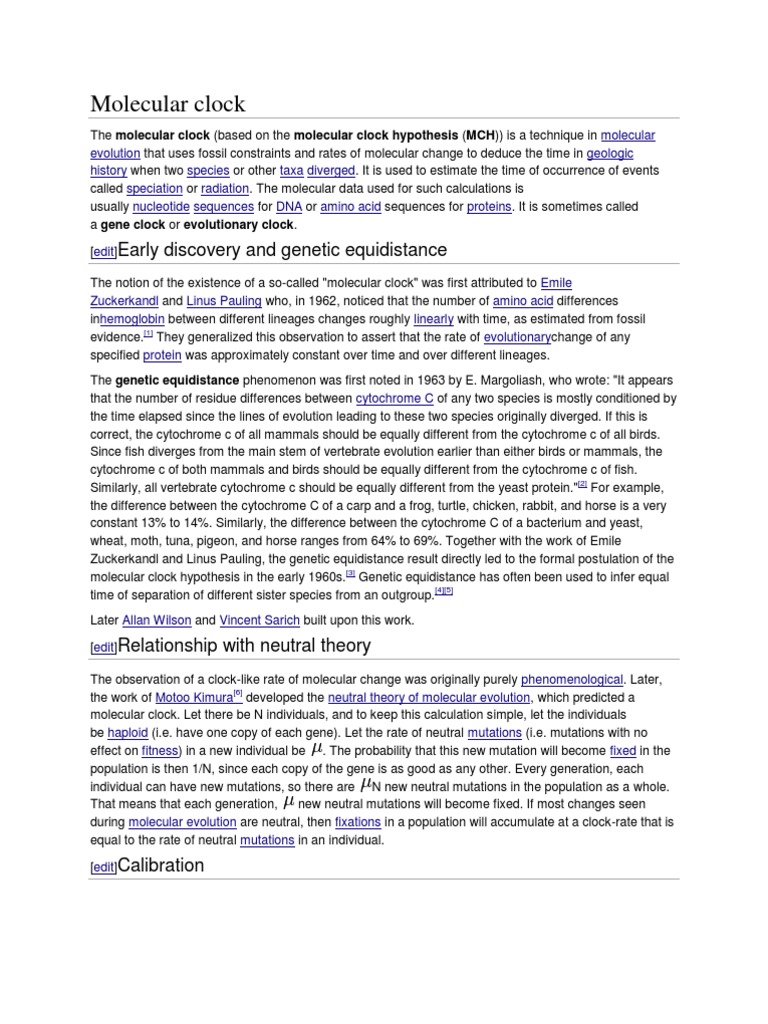The concept of molecular clocks serves as a foundational cornerstone in the field of evolutionary biology and genetics, allowing scientists to estimate the timing of evolutionary events through the mutation rates of biomolecules. This intricate mechanism of genetic timekeeping provides invaluable insights into the temporal aspects of evolutionary divergence and speciation events. Within this discourse, we will elucidate the various components and implications of molecular clocks, while also examining the methodological approaches employed in their application.
In essence, a molecular clock employs rates of molecular evolution to infer the passage of time in the evolutionary history of organisms. Genetic markers, such as nucleotide sequences of DNA or protein structures, serve as chronological indicators that accumulate mutations at relatively consistent rates. This constancy in mutation rates allows researchers to effectively translate molecular data into phylogenetic timelines.
The genesis of molecular clock theory can be traced back to several pivotal studies in the mid-20th century, notably those conducted by Emile Zuckerkandl and Linus Pauling. Their groundbreaking work on the genetic divergence observed in hemoglobin sequences laid the groundwork for the mitochondrial DNA applications that would follow. The fundamental proposal emerged: the greater the genetic divergence between species, the more time has elapsed since their common ancestor. This principle has since been corroborated through extensive empirical research, yielding a plethora of molecular clock models and approaches.
One of the primary variants of molecular clocks is the **strict molecular clock**, which posits a fixed mutation rate across lineages. This model operates under the assumption that genetic changes occur at a uniform temporal rate, facilitating simplified analysis of divergence times. However, this paradigm often faces scrutiny, as evolutionary processes can exhibit significant variability depending on ecological factors and selective pressures. Consequently, researchers often encounter the dilemma of calibrating these clocks accurately, particularly when employing rate assumptions that may not hold true across diverse taxa.
In response to the limitations inherent in strict molecular clocks, the **relaxed molecular clock** model emerged. This more nuanced approach accommodates variations in mutation rates by allowing for fluctuations within different branches of a phylogenetic tree. By leveraging sophisticated statistical methods, such as Bayesian inference, scientists can derive more reliable estimates of divergence times, ultimately providing a more holistic understanding of evolutionary dynamics.
Calibration is a crucial component in the effective application of molecular clocks. To ensure temporal accuracy, researchers draw upon fossil records and biogeographical data to anchor their molecular findings. The integration of such external reference points helps to mitigate the potential discrepancies that can arise from assuming constant rates of evolution. For instance, the calibration of molecular clocks has necessitated intricate comparisons between genetic sequences and the well-documented timeline of paleontological discoveries, elucidating the relationship between molecular data and fossil evidence.
Another notable dimension of molecular clocks involves the utilization of **mitochondrial DNA (mtDNA)** as a genomic repository for evolutionary history. mtDNA has proven advantageous in population genetics due to its maternal inheritance pattern and relatively rapid mutation rates. These characteristics render mtDNA an excellent tool for investigating the evolutionary relationships among species, particularly in the context of human ancestry studies. The discovery of specific markers within mtDNA has allowed researchers to trace lineage back thousands of years, unveiling critical narratives about human migration and the evolutionary history of ancestral populations.
Moreover, researchers have identified various limitations and challenges associated with the application of molecular clocks. Genetic recombination, varying mutation rates among different species, and the complex interplay of selection processes can all confound estimations of divergence times. Furthermore, potential saturation of genetic sequences, where the accumulation of mutations exceeds the observable divergence, can obscure historical signal and lead to inaccurate conclusions.
The role of molecular clocks also extends beyond mere temporal estimates; these genetic timekeepers offer profound insights into the evolutionary processes themselves. By investigating the rate of molecular evolution, scientists can elucidate the dynamics of adaptive radiations, the emergence of antibiotic resistance, and even the impact of global climatic shifts on species diversification. Through these lenses, molecular clocks illuminate the intricate tapestry of life on Earth, providing a more comprehensive understanding of how organisms adapt to their environments across geological time scales.
As the scientific community continually refines its understanding of molecular clocks, emerging technologies such as next-generation sequencing are poised to enhance the resolution and accuracy of evolutionary timelines. The advent of such methodologies facilitates the exploration of previously intractable genomic data, expanding the horizon of evolutionary inquiry. This heralds a new chapter in the elucidation of Earth’s biological history, fostering an interwoven understanding of continuity and change across the vast annals of evolutionary time.
In conclusion, the study of molecular clocks and genetic timekeeping is an evolving field replete with complexities and challenges. From their historical origins to contemporary applications, molecular clocks serve not only as tools for estimating evolutionary timelines but also as gateways into the mechanisms of evolutionary processes themselves. As researchers delve deeper into the molecular underpinnings of life, the implications of these timekeepers will resonate throughout the disciplines of anthropology, genetics, and evolutionary biology, shaping our comprehension of life’s intricate narrative on this planet.
